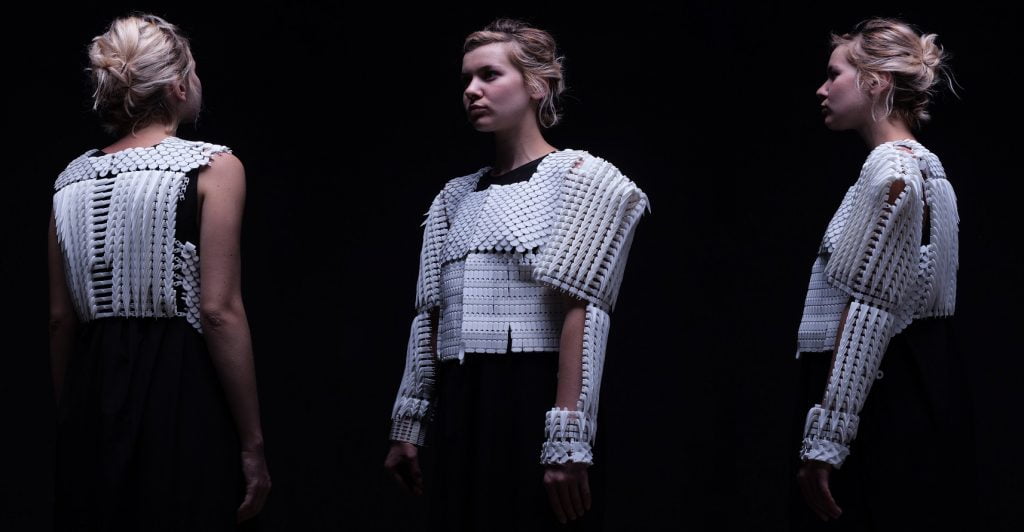Over the past decade, 3D technology has been used in the fashion world to create innovative, sophisticated works of art that test the boundaries of talent and imagination. Israeli designers, Danit Peleg and Noa Raviv, graduates of the prestigious Shenkar College of Engineering, Design and Art, made international headlines with their use of 3D printing for fashion. Peleg created the world’s first entirely 3D printed fashion collection, and Raviv, whose work has been displayed in the New York Metropolitan Museum of Art, created a 3D print collection by manipulating digital images using computer modeling software. Late last year, Israeli textile designer Eden Saadon used a 3D printing pen for a lacy lingerie collection.
Another Israeli designer, Nitzan Kish, has been using 3D tech to create uniquely shaped clothing and jewelry with a special purpose in mind – self-defense, specifically in urban environments. Her collection, Me, Myself & I, first released in 2015, features garments that turn into spikes and look like modern body armor.
“The question is why is there a need for armor in the public sphere. And the answer is that there is no other choice at the moment,” she tells NoCamels.
“Women are exposed to all types of situations. Harassment, rape, assault. Today surveys show that at least 1 in 2 women say they have been harassed, sexually or otherwise, publicly, but we all know it’s likely higher than that,” she says, adding that the discussion surrounding the issue, partly generated by the #MeToo movement, is a big achievement.
In Israel, one in every three women suffers a sexual assault during her lifetime, and one in every seven women is raped, according to the Association of Rape Crisis Centers in Israel. In the US, one out of every six American women has been the victim of a rape or attempted rape in her lifetime, according to RAINN (Rape, Abuse & Incest National Network).
“It’s important to talk about these things and to have the conversation, to create change,” she says.
Her pieces are indeed a conversation-starter. The clothing interlocks at the torso and moves smoothly with the body, yet upon any physical force, the garment changes shape and becomes a self-defense mechanism.
Kish speaks about self-defense and assault from personal experience. Trained in Karate and Ninjutsu from a young age, she had her own harrowing experience while a student at Jerusalem’s Bezalel Academy of Arts and Design in her final year and in the midst of her final project. The incident led her to think further about such self-defense clothing.
“I was on a bus one day packed with people, mainly students, and a man started threatening me, he didn’t touch me but he was very close and very hostile, and despite my training [in martial arts] I froze, I just froze and couldn’t move,” she recounts. Kish says it took the intervention of someone else to make her snap out of the state she was in.
The second time a similar incident happened, Kish says she had already finished her collection and happened to have one of the garments with her and she says it gave her the strength to respond. “This man tried to touch me and I just felt empowered, I ran to the bus driver who stopped the vehicle and called the police. Meanwhile, the man escaped but I didn’t freeze, I did something,” she says.
SEE ALSO: Israeli Textile Designer Reshapes Fashion Tech With 3D Pen For Kids
Kish calls attention to the 3D designs for other reasons too – they are cost-effective, environmentally friendly and creates a serious buzz in the fashion world she wasn’t expecting, she tells NoCamels. “What’s really cool about the 3D design is not only that the materials are 90 percent less damaging in the processes of development, but my material is also 50 percent recycled,” Kish says.
From today #photoshoot @MizNK3D pic.twitter.com/XGlVcD15vy
— Nitzan Kish (@MizNK3D) September 23, 2016
Sign up for our free weekly newsletter
Subscribe
“What’s interesting about the technology and the idea behind it is that people are curious to learn more because they haven’t seen something like this before,” Kish tells NoCamels, adding that the tech should be made more accessible.
Kish maintains a space at Impact Labs in Tel Aviv, a first-of-its-kind 1,000 sq. meter hardware innovation center launched last year by the Reut Group in partnership with shared workspace giant WeWork. Impact Labs provides entrepreneurs, companies, and social innovators with access to state-of-the-art hardware and design tools, including IoT and electronic labs, laser cutters, high-end 3D printing, photography and 3D scanning, metal and, robotics.
Kish does a lot of her work at Impact Labs, where she has access to the tools and design software for her projects and has so far made three different jewelry collections. Her jewelry, an intricate jumble of fashionable and colorful shapes oriented in nylon, uses the 3D printing techniques to make jewelry much lighter than it would be if it were made of gold, for instance. Kish meets one-on-one with her clients and customizes the 3D garments and jewelry to fit their taste, color, and texture.

Jewelry by Nitzan Kish. Photo by Marina Moshkovich
She tells NoCamels that she is consulting with other innovators at Impact Labs for her next creation – “Wonder-Jewel,” a collection of smart jewelry that incorporates sophisticated sensors into the accessories.
“The ‘smart jewelry’ startup is empowering in that, for example, if something happens to a wearer 50 meters away, she can alert the sensor on her jewelry and a trusted member of her community will receive a cell phone notification to arrive at the scene immediately,” says Kish, who adds that it could also be applied to the elderly population, especially those who live alone and can be susceptible to falls.
SEE ALSO: The Future of Food? How New Israeli Tech Could Have You Eating Meals Made By A 3D Printer
The enhanced jewelry collection is set to be available for purchase in about a year, says Kish, who emphasizes that the idea of real-time alert systems is resonating with many.
She tells NoCamels that she is also working on a project that incorporates the clothes and the jewelry together but wouldn’t elaborate further.
Kish says that after years of teaching 3D printing techniques to students and becoming an expert in the field, the technology has given her the ability to experiment imaginatively with design and color in ways she once could not do using more traditional techniques.

Jewelry by Nitzan Kish. Photo by Marina Moshkovich
Three-D printing has led to innovation in many other fields as well, including construction, medicine, vehicles, warfare, and food. For instance, Chinese company Winsun built the first ever 3-D five-story apartment complex. In the car industray, Local Motors in 2015 unveiled designs for a 3D customized Strati car. And one of the most controversial 3D prints of all time was a plastic gun developed by 25-year-old Texas resident Cody Wilson in 2013, 3D Liberator. The design was uploaded online for free before the government ordered it removed.
And as the 3D industry advances, we are bound to see new innovations.
Kish, for her part, says she is focused on creating works that empower people and give them strength.
Related posts

Editors’ & Readers’ Choice: 10 Favorite NoCamels Articles

Forward Facing: What Does The Future Hold For Israeli High-Tech?

Impact Innovation: Israeli Startups That Could Shape Our Future




Facebook comments